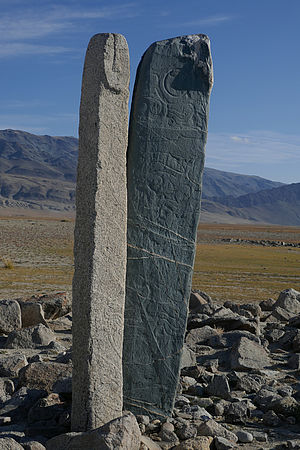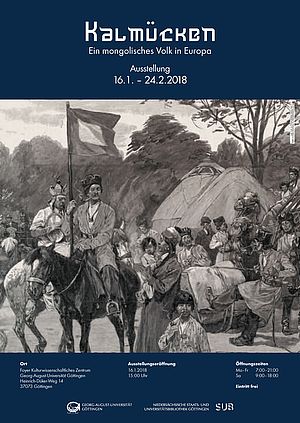2020
Speaking Stones - Pre- and Protohistoric Societies of Central Asia Reflected in their Rock Drawings

The exhibition „The Stones are speaking to us. Pre- and Protohistoric Societies of Central Asia Reflected in their rock art” at the University of Göttingen offers insights into early, script-less cultures. It shows photographs of petroglyphs, cave paintings and early sculptures from Central Asia.
Dr. Reckel took the photographs during his many journeys through Mongolia, Kyrgyzstan and Kazakhstan, where there are especially many petroglyphs. These petroglyphs were carved into smooth, often naturally polished stone surfaces with stone or later with metal tools. Some are dated to the Stone Age, but most petroglyphs were made in the Bronze and Iron Age. They show people, hunting game, domestic animals or horse drawn carts, but also ritual dances, shamans and sun gods. In addition to the petroglyphs, Bronze Age deer stones and late Iron Age stelae with human-like features lead the exhibition into early historic times. Some stone figures give an insight into the old Turkic culture of Mongolia.
The exhibition was shown from January 30th to March 20th 2020 in the foyer of the Centre for Cultural Studies at the University of Goettingen.
Slideshow exhibition pictures
Related Publication
2018

Kalmücken – ein mongolisches Volk in Europa
Seit über 200 Jahren erforscht die Georg-August-Universität Göttingen die Sprache und Kultur der Kalmücken. Bereits im 18. Jahrhundert kamen kalmückische Manuskripte, Drucke und ethnographische Objekte nach Göttingen. In der Ausstellung „Kalmücken – ein mongolisches Volk in Europa“ präsentierten wir Objekte dieser einzigartigen Sammlung sowie aktuelle Zeugnisse der kalmückischen Kultur. Die Themen reichten von einer historischen Einordnung des Volkes über deren Begehrtheit als lebende Ausstellungsobjekte im Europa des 19. und 20. Jahrhunderts sowie den persönlichen Bericht einer unter Stalin deportierten kalmückischen Familie bis hin zu Fotos des heutigen Lebens der Kalmücken. Die Ausstellung zeigte zudem, dass der Kontakt mit den Kalmücken den Auftakt der Mongolistik in Deutschland und an der Universität Göttingen darstellt.
